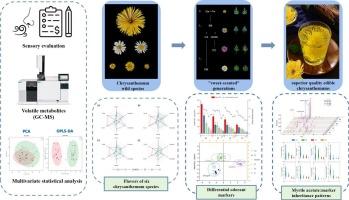基于感官评价和多元统计分析的6种菊花香气特征比较研究,为甜菊栽培提供对策
IF 9.8
1区 农林科学
Q1 CHEMISTRY, APPLIED
引用次数: 0
摘要
食用菊花品种香气相对较轻,野菊花香气特征多样。本文研究了6种菊花(chrysanthemum indicum var. aromaticum, Cia)、lavandulifoliu (chrysanthemum Cl)、vestitum (Cv)、chrysanthemum indicum (Ci)、chrysanthemum oreastrum (Co)和chrysanthemum morifolium‘Huang Xiang Li’(CmHXL)的香气特征。采用感官评价和顶空固相微萃取气相色谱-质谱联用技术(HS-SPME-GC-MS)鉴定了79种挥发性化合物。主成分分析(PCA)和正交偏最小二乘判别分析(OPLS-DA)发现了17个标记化合物,包括桃金娘烯酯、桉油和菊花烯酮,将该物种划分为3个不同的香气群。此外,还研究了Cia香气物质的代际遗传。结果表明,桃金娘烯酯乙酸含量显著下降(代际间下降63.16 % ~ 95.79 %),表明香气遗传面临挑战。本研究鉴定了菊花中独特的芳香资源,为克服遗传挑战的甜味食用品种开发提供了新的见解。本文章由计算机程序翻译,如有差异,请以英文原文为准。


Comparative investigation of aroma characteristics of six chrysanthemum species based on sensory evaluation and multivariate statistical analysis to provide a strategy for the cultivation of sweet-scented chrysanthemums
Edible chrysanthemum cultivars possess relatively light aroma, while wild chrysanthemums exhibit diverse aroma characteristics. This study investigated the aroma characteristics of six chrysanthemum species, including Chrysanthemum indicum var. aromaticum (Cia), Chrysanthemum lavandulifoliu (Cl), Chrysanthemum vestitum (Cv), Chrysanthemum indicum (Ci), Chrysanthemum oreastrum (Co), and Chrysanthemum morifolium ‘Huang Xiang Li’ (CmHXL). Using sensory evaluation and headspace solid-phase microextraction gas chromatography–mass spectrometry (HS-SPME-GC–MS), 79 volatile compounds were identified. Principal Component Analysis (PCA) and Orthogonal Partial Least Squares Discriminant Analysis (OPLS-DA) revealed 17 marker compounds, including myrtenyl acetate, eucalyptol, and chrysanthenone, which classified the species into three distinct aroma groups. Additionally, the inheritance of aroma compounds in Cia across generations was studied. Results showed a significant decline in myrtenyl acetate content (63.16 % to 95.79 % reduction across generations), indicating challenges in aroma inheritance. This study identified a unique aromatic resource in Chrysanthemum, offering novel insights for sweet-scented edible cultivar development despite genetic challenges.
求助全文
通过发布文献求助,成功后即可免费获取论文全文。
去求助
来源期刊

Food Chemistry
工程技术-食品科技
CiteScore
16.30
自引率
10.20%
发文量
3130
审稿时长
122 days
期刊介绍:
Food Chemistry publishes original research papers dealing with the advancement of the chemistry and biochemistry of foods or the analytical methods/ approach used. All papers should focus on the novelty of the research carried out.
 求助内容:
求助内容: 应助结果提醒方式:
应助结果提醒方式:


